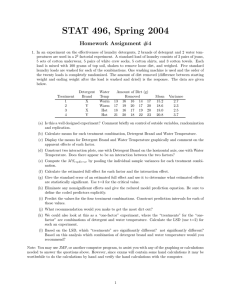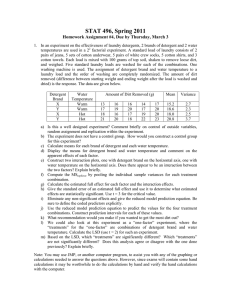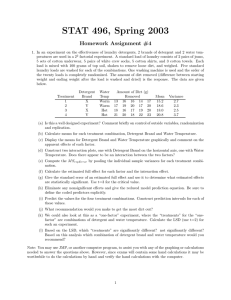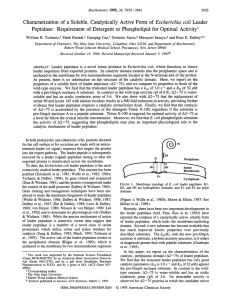Statistics 496, Applied Statistics for Industry II Name: Exam 2, Spring 1997 Site:
advertisement
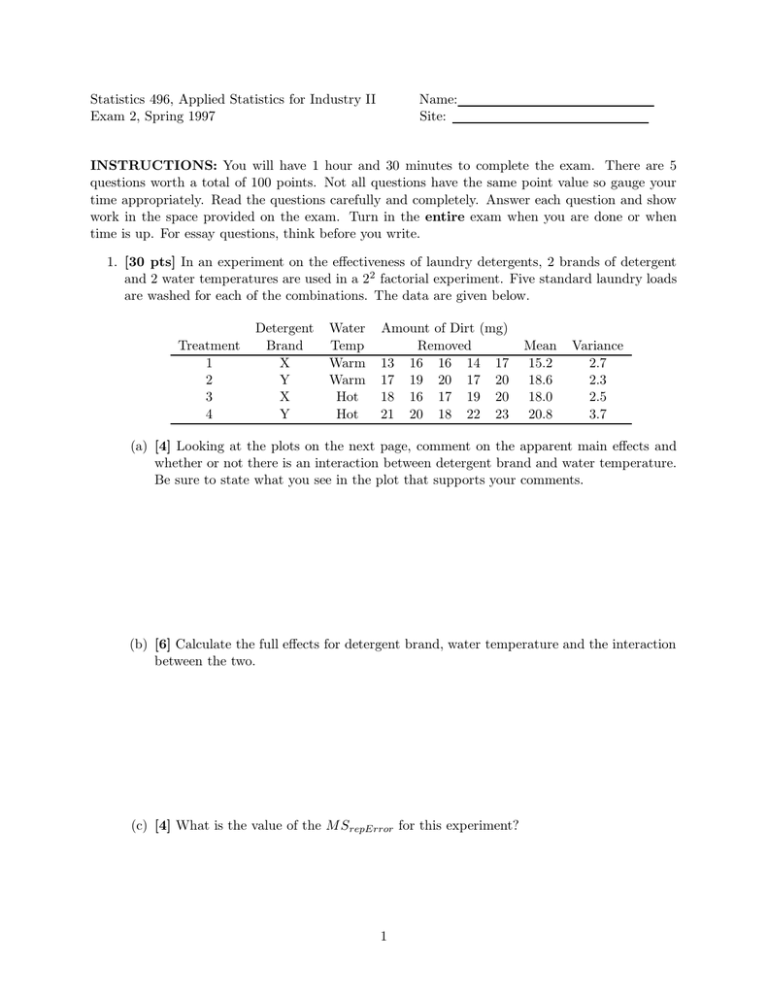
Statistics 496, Applied Statistics for Industry II Exam 2, Spring 1997 Name: Site: INSTRUCTIONS: You will have 1 hour and 30 minutes to complete the exam. There are 5 questions worth a total of 100 points. Not all questions have the same point value so gauge your time appropriately. Read the questions carefully and completely. Answer each question and show work in the space provided on the exam. Turn in the entire exam when you are done or when time is up. For essay questions, think before you write. 1. [30 pts] In an experiment on the effectiveness of laundry detergents, 2 brands of detergent and 2 water temperatures are used in a 2 2 factorial experiment. Five standard laundry loads are washed for each of the combinations. The data are given below. Treatment 1 2 3 4 Detergent Brand X Y X Y Water Temp Warm Warm Hot Hot Amount of Dirt (mg) Removed 13 16 16 14 17 17 19 20 17 20 18 16 17 19 20 21 20 18 22 23 Mean 15.2 18.6 18.0 20.8 Variance 2.7 2.3 2.5 3.7 (a) [4] Looking at the plots on the next page, comment on the apparent main effects and whether or not there is an interaction between detergent brand and water temperature. Be sure to state what you see in the plot that supports your comments. (b) [6] Calculate the full effects for detergent brand, water temperature and the interaction between the two. (c) [4] What is the value of the M SrepError for this experiment? 1 2 (d) [6] Which of the effects in (b) are statistically significant? How do you know? (e) [2] What recommendation would you make to get the most dirt out? (f) [4] We could also look at this as a “one-factor” experiment, where the “treatments” for the “one-factor” are combinations of detergent and water temperature. Calculate the LSD (use t=2) for such an experiment. (g) [4] Based on the LSD, which “treatments” are significantly different? not significantly different? Based on this analysis which combination of detergent brand and water temperature would you recommend? 3 2. [10 pts] You will need the sample size tables in order to answer the following questions. A copy is attached at the end of the exam. We wish to run an experiment with three factors each at two levels. (a) [2] How many treatment combinations are there? (b) [3] Using the sample size tables, with ALPHA=0.05 and BETA=0.10, how many experimental units (total) do we need if we wish to detect a difference in treatment means as small as 1.4σ? (c) [5] Resources limit us to 5 experimental units per treatment combination. What size difference in factor means (e.g. ȲA−High − ȲA−Low ) can we detect with ALPHA=0.05 and BETA=0.05? 3. [10 pts] We have discussed two randomization schemes in the course so far. These are the completely randomized design (CRD) and the randomized complete block design (RCBD). Discuss advantages and disadvantages of each design and indicate when you would use each. 4 4. [35 pts] The following problem is adapted from a problem given in Statistical Quality Design and Control by DeVor, Chang and Sutherland, p. 609-610. A fisherman conducted an experiment using 5 factors each at 2 levels. The factors and levels are given below. The response is the number of fish (bluegills) caught in a four hour period. All experimental trails were performed at a lake stocked with bluegills in northern Wisconsin. Refer to the Minitab analysis and the normal plot of estimated effects. Variable A: Fishing location B: Bait type C: Time of day D: Weather E: Hook size Low Level (–1) Pier Worms Day No rain Small High Level (+1) Boat Nightcrawlers Night Rain Large (a) [3] What are the experimental units in this experiment? (b) [4] Do you see any possible difficulties with performing a completely randomized experiment? Explain briefly. Hint: it may help to explain what a completely randomize experiment is. (c) [5] Looking at the normal plot, which of the estimated effects appear to be significant? List them here and label them on the normal plot. 5 6 7 (d) [5] If we had decided before hand to use 4-way and 5-way interaction terms to estimate the “Error” variability, what are the values of SS “Error00 , df“Error00 , and M S“Error00 ? (e) [5] Give the prediction equation that includes only those terms that are statistically significant. (f) [4] What would your recommendation be if we wished to maximize the number of fish (bluegills) caught? (g) [5] What is the predicted value at that “best” combination and the prediction interval? (h) [4] Could you also estimate “Error” by dropping a single factor from the analysis and getting pseudo-replication? If not, why not? If so, which factor would you drop and how many degrees of freedom would you have for pseudo-replication error? 8 5. [15 pts] An experiment is performed on a nitride etch process on a single-wafer plasma etcher. This process is used in the manufacture of computer chips. Two variables, the gap between anode and cathode and the power applied to the cathode are investigated. Two observations at each of the four treatment combinations along with four center point observations are taken in a completely random order. The response variable is the etch rate for silicon nitride. Refer to the Minitab output on the next page. (a) [5] What effects are statistically significant? You must justify your answer by making a comparison to a critical effect size or test statistic. (b) [5] Is there a significant curvature effect? Again, justify your answer with the value of the appropriate test statistic. (c) [5] Another analysis uses the linear and quadratic coded values of power to come up with a regression model. According to the Minitab output the t-statistic indicates that the quadratic term is not significant. Does this agree with your finding in (b). If so, explain why. If not, explain why not. 9 10
